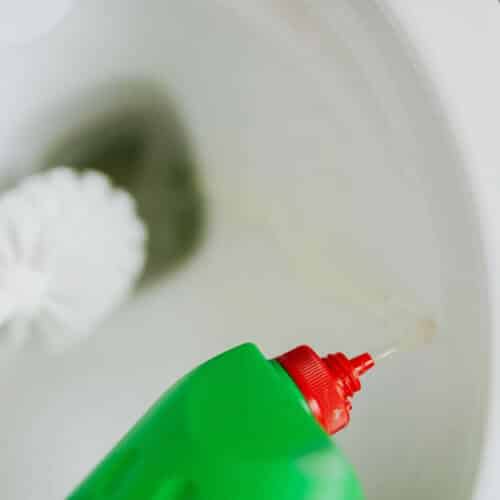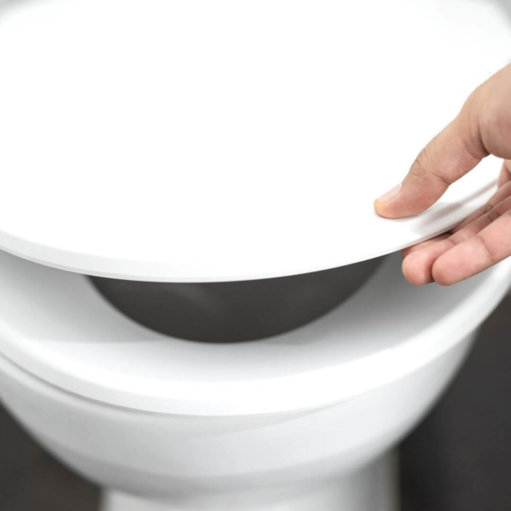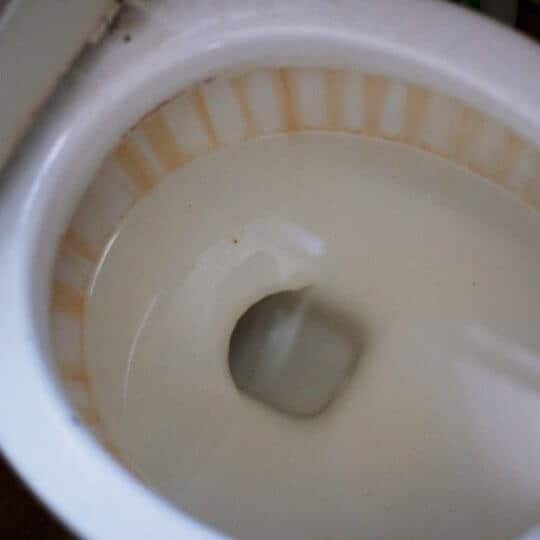Have you ever wondered “Why is my toilet water blue?” Now it’s time to find out!
Toilets are vital appliances in every home. We use them every day and they enable us to practice a high level of hygiene.
However, don’t take the good functioning of your toilet for granted. Using this fixture several times a day for years and years causes wear and tear. As a result, some parts may need to be replaced every once in a while.
Best is to check your toilet condition regularly so you can solve problems before they become too large.
In this post we will talk about an unusual sign that something is going wrong.
Why is my toilet water blue & what turns toilet water blue?

There are three main causes why your toilet water can turn blue. If you want to find out what turns toilet water blue, keep on reading:
- Corrosion in copper piping
This phenomenon causes either blue or green toilet water. Copper oxide has a green-blueish color and it can cause your toilet or tap water to become blue as well. This is a problem that needs to be addressed quickly as corrosion can damage both your piping and toilet.
- Blue toilet water tablets
Many people use in-tank toilet cleaners also known as toilet water tablets. These chemicals are added in the toilet tank water to reduce staining and foul odors. They are also used to prevent mold and limescale buildup.
If the tablets are blue, they will obviously cause the toilet water to turn blue.
- Naturally high levels of copper in your water
Some areas, such as Minnesota, can have high levels of naturally-occurring copper in water. This is something you cannot control. However, you can solve the problem by installing a water filtering system.
What causes blue ring in toilet bowl?

One version of the blue toilet water problem is blue ring in toilet bowl. When this happens, it often comes as a surprise, but the cause can be hiding inside your water supply.
This blue ring usually rims the bowl at the same height as the usual water level in the bowl. It is also possible to see blue stains around the top of the bowl, where water pours in. if you don’t take measures, the blue ring usually expands and colors a larger area of the toilet bowl.
Again, the cause of the blue ring is elevated levels of copper in your water supply. This causes your toilet water to be more acidic than normal. Higher copper levels do not affect the quality of water. What it does is it causes stains on the white porcelain that the toilet bowl is made of.
What other colors can toilet water have?

Blue is not the only unusual color that your toilet water can have. Depending on the chemicals found in your toilet water, you may notice some other colors too:
- Red, brown or orange
The cause of red, brown or orange toilet water is easy to guess: rust. Rust can come from galvanized iron or steel plumbing. Plumbing containing iron oxidizes if the protective zinc layer wears out.
Rusty water will make your food taste strange and stain your clothing. In toilets, it will cause rust deposits on the bowl.
- Green
Copper plumbing corrosion and algae buildup are the main culprits of green toilet water. Clearing the plumbing system of algae is fairly simple. However, if the green hue is caused by copper plumbing, best is to call a professional. Large and continuous intake of green water can cause various health problems.
- Yellow
Yellow color is usually caused by repairs or cleanups performed at the city’s water distribution center.
- Pink or purple
Pink toilet water indicates the presence of potassium permanganate, which is used to oxidize iron and manganese. When too much of this substance is present, water will turn purple.
- Black
Black suggests mildew growth in your plumbing. A plumber should investigate the cause as water contaminated with mold is dangerous for human health.
Is blue toilet water dangerous?
Wondering “is blue toilet water dangerous?” High level of copper can have a negative effect on human health and on your piping system.
- How copper can influence human health
If your toilet water is blue, chances are your tap water contains too much copper as well. Ingesting too much copper can cause vomiting, diarrhea, nausea, stomach cramps, liver damage, and kidney disease. Infants under one year old are particularly sensitive to copper and their bodies are not able to eliminate this substance easily.
- Effects on your plumbing
Blue water itself does not damage your plumbing systems but is a side effect of corrosion. This means that your copper pipes are already damaged and you should replace them. Some homeowners prefer replacing with plastic pipes to avoid similar problems in the future.
When the blue color of the toilet water is caused by blue toilet water tablets, there can be some issues. These are presented in the following section.
Using blue toilet water tablets – pros and cons
Everybody likes a fresh toilet, without having to wash and scrub after each use. This is why various toilet cleaning products and disinfectants have been developed. The use of such products maintains the toilet smelling fresh and clean for days.
One of the widely-used toilet products is blue toilet water tablets. They are so convenient because you just put them in the toilet tank. You don’t have to touch the toilet bowl to use them. They don’t create much waste. More importantly, they do their job every time you flush the toilet.
On the other hand, there are some cons against using these blue toilet water tablets:
- They can cause damage to toilet and plumbing
In-tank cleaners have been associated with various toilet malfunctions. These drop-in toilet cleaners seem like a simple solution, but can cause a lot of trouble. They contain harsh chemicals that keep the toilet clean but also eat at its sensitive components.
These tablets reduce the working life of toilet parts such as the flush valve and the flapper. The chemicals in toilet tablets are alkaline and cause rubber pieces such as gaskets to become brittle. So, blue toilet water tablets can cause more harm than good.
- They can be harmful for the environment
Chlorine in toilet tablets does not represent a problem as sewage systems eliminate this substance. However, if you are not connected to the city sewage, these chemicals will contaminate the soil around the septic tank.
The presence of harsh chemicals in toilet bowl can also have a negative impact on your home environment. Exposing your lungs to such substances is not a good idea.
- They can be a hazard for pets
The Internet abounds in questions such as “My dog drank blue toilet water, what do I do now?”
Do you have pets? Best is to make sure that toilet water is not toxic, in case they drink from it by accident.
How to get rid of blue toilet water?
Many concerned homeowners want to find out how to get rid of blue toilet water. We are referring here to blue water caused by high copper levels. There are two directions you can take:
- Treating symptoms
Especially when you notice a blue streak on your toilet bowl, you can clean it regularly. This way you prevent the discoloration from building up and becoming even harder to remove.
- Treating the cause
Unless you eliminate the actual cause of blue toilet water, the problem will persist.
What turns toilet water blue in most cases is high copper levels.
If the copper oxide is caused by corrosion in your copper pipes, you will need to replace the damaged pipes.
If copper occurs naturally in your running water, you will need a water filter system. This is important when you drink your tap water and cook with it. The area where you live can have soil that is rich in copper. This occurrence is common in mining areas.
There are different commercially-available water filters that you can use. They will improve water quality and eliminate other harmful substances as well, not just copper:
- Ion exchange filters – also good at eliminating hardness caused by various minerals;
- Reverse osmosis filters – they use a membrane that retains foreign substances and can eliminate up to 97% of copper from drinking water;
- Activated carbon filters – are also effective at filtering out BPA, phenol and other absorbable contaminants.
So “why is my toilet water blue?”
Unless you use blue toilet water tablets, the answer is: due to elevated copper levels. Copper oxide can come either from corroded pipes or from the environment. You need to take action depending on the severity of the problem and what causes it.

Michael Davis is a heating & plumbing expert who currently works as independent contractor in SC. He also writes for Plumbertip.
For almost 10 years he worked on various plumbing tasks across South Carolina.


